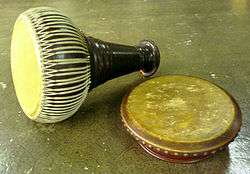Pong lang
The pong lang (Thai: โปงลาง, RTGS: ponglang, Thai pronunciation: [pōːŋ.lāːŋ]) is a wooden xylophone from the Isan region of northeast Thailand.[1][2] The instrument may be played as a standalone instrument, in pairs with one player playing melody and the other harmonizing, or as part of an orchestra.[2] Players use carved two hardwood mallets.[2]
.jpg) Pong lang xylophone, front. The instrument is made of shaped logs, tuned by removing wood from the center. | |
| String instrument | |
|---|---|
| Classification | Plucked string instrument |
| Hornbostel–Sachs classification | 111.212 (Sets of percussion sticks in a range of different pitches combined into one instrument, struck with a non-sonorous object) |
The instrument isn't standardized and the number of tone bars and their size can vary.[2] Unlike the Ranat ek lek and Ranat thum lek which are strung over a box, the pong lang is hung from a post or tree with the string of tone bars arcing down toward the ground.[2] wide to short. The number of tone bars varies, and 12 or 15 tone bars may make up a set. The wider bars with lower pitch sit at the top of the string and the other end (with smaller high-pitched bars) may be hooked to the player's toe or to a belt around the player's waist.[2]
When there are two performers, they may sit on opposite sides of the post, facing one another. With two instruments, one plays the melody, the other plays a drone accompaniment or harmonics.[2] The pong lang is used for all kinds of occasions, especially for festivals and ceremonies. The instrument can be played solo or in an ensemble.
References
- "โปงลาง [translation: Ponglang]". prapayneethai.com. Retrieved 18 June 2019.
"Ponglang" is a native instrument... of Isaan originating in Kalasin Province. Therefore is considered a symbol of Kalasin province...
- "โปงลาง [ translation: Ponglang]". Office of the National Culture Commission (NSTDA), Thailand Ministry of Culture. Retrieved 18 June 2019.
a musical instrument...in the northeast... made of hardwood, various sizes...
